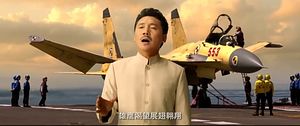Generally, military experts and China wonks don’t spend much time pouring over music videos featuring Tibetan folk singers—at least, not in the line of duty. This week is an exception. China has released the first official video footage of its new aircraft carrier, including scenes of aircraft taking off and landing on the deck of the Liaoning. It just so happens that the two new videos are each music videos, with one set to instrumental music and the other featuring a full-blown ballad.
The “Leading the Dream” music video:
The “Flying Sharks” instrumental music video:
Both videos were produced by the state-owned Aviation Industry Corporation of China (AVIC), which held an official release ceremony in Beijing to showcase the films. At the ceremony, AVIC Spokesman Zhu Hongbin explained the purpose behind the videos. According to Zhu, as quoted by People’s Daily [Chinese], they were made to increase patriotism enthusiasm, to attract more young Chinese to dedicate themselves to China’s aircraft and aircraft carrier development projects, and to more generally encourage young Chinese to realize the “Chinese Dream.” Later, Zhu added that the video was supposed to advance Chinese people’s understanding of developments in the national security industry, as well as boosting their nationalistic self-confidence and self-esteem. Quite a tall order for two videos, each running under seven minutes.
Zhu also tried to claim the video as a step forward in military transparency. Zhu said that the video creators spent time living with the aircraft carrier personnel, coming to understand their daily routines. The video, he said, was an artistic representation of what actually happens on the carrier. I doubt this is the sort of military transparency U.S. government officials had in mind, but perhaps that’s not the point. Zhu seemed more concerned with domestic transparency—allowing the Chinese people themselves a glimpse of the national defense industry’s latest achievements.
Of course, although Zhu didn’t mention it, there’s also an underlying profit motive. AVIC was in charge of refitting the Liaoning after it was purchased from Ukraine, so shining a glamorous spotlight on the carrier reflects well on AVIC. The company also manufactures the carrier-based J-15 aircraft, known as the “Flying Shark,” which are featured heavily in the videos. AVIC even dedicated the videos to all the workers toiling anonymously on China’s aircraft carrier project—a designation that, coincidentally, would include many of AVIC’s own employees.
So how does one make a music video showcasing an aircraft carrier? Take plenty of glamor shots of Liaoning from afar, particularly when the carrier is bathed in the glow of a sunset. Add footage of handsome men (presumably sailors) working out on the Liaoning’s deck. And of course, the piece de resistance, showcase aircraft actually taking off from the deck and soaring through the air before coming back in for a landing. Finally, add a soaring soundtrack where the singer belts out hyperbolic phrases like “the ocean is surging power” and “sweat endlessly reaps the reward of glory.”
The lyrics of the music video are pretty standard calls to patriotism. The words both extol those who already give their sweat and blood for China and encourage the country to reach still higher in its quest to fulfill the China dream. The video ends with several lines of text just in case viewers somehow missed the point: “Our homeland will ultimately choose those who are loyal to it. Our homeland will ultimately remember those who dedicate themselves to it. We pay our respects to those heroes who have worked their hearts out for China’s aircraft carrier.”
What’s different is obviously the same thing that attracted worldwide attention in the first place: the inclusion of footage featuring the Liaoning and its sailors. China’s navy has traditionally been relegated to second fiddle, both in the military totem pole and in the popular imagination. That the Liaoning, perhaps China’s most visible symbol of national pride, is part of the navy speaks volumes as to the increased stature of this branch of the armed forces. The video is serious PR, not just for Chinese patriotism or even just for the Liaoning, but for the navy as a whole, especially its aviation branch. As one fan of the video told Global Times, the short film “made many people realize that Chinese aircraft could be cool.”
Between these videos and U.S. Secretary of Defense Chuck Hagel’s recent tour of the Liaoning (the first ever by a foreign official), China is apparently fully ready to roll out its navy’s pride and joy as a PR tool. As Li Jie, an expert from a prominent Chinese military think tank, told Global Times, “this voluntary display reflects the growing confidence of Chinese military power.” Liaoning was always intended as a visible symbol of China’s new military stature—having an aircraft carrier is a milestone for China to pass on its way to becoming a world-class naval power. Now, a year and a half after the Liaoning was commissioned, China is finally comfortable enough with its new toy to start really showing it off.

































